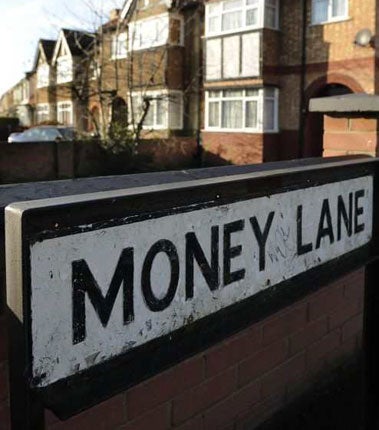Borrowers hit with new, higher-rate mortgages </p><p>as fixes come to an end
Before the crash, homeowners moving from a lower-cost deal could expect a discount on their lender's standard offer. Not any more. Julian Knight reports

Your support helps us to tell the story
From reproductive rights to climate change to Big Tech, The Independent is on the ground when the story is developing. Whether it's investigating the financials of Elon Musk's pro-Trump PAC or producing our latest documentary, 'The A Word', which shines a light on the American women fighting for reproductive rights, we know how important it is to parse out the facts from the messaging.
At such a critical moment in US history, we need reporters on the ground. Your donation allows us to keep sending journalists to speak to both sides of the story.
The Independent is trusted by Americans across the entire political spectrum. And unlike many other quality news outlets, we choose not to lock Americans out of our reporting and analysis with paywalls. We believe quality journalism should be available to everyone, paid for by those who can afford it.
Your support makes all the difference.Borrowers coming to the end of a fixed rate mortgage term may be automatically switched on to deals which are even more expensive than the lender's standard variable rate (SVR), experts have warned.
Usually, when fixed rate mortgage deals came to an end, borrowers were shunted on to the SVR. But in some instances, more fortunate borrowers would be moved on to a "retention rate" which was generally lower than their lender's SVR. The idea behind retention rates was to persuade the borrower not to switch provider by giving them a discount off SVR. However, with Bank of England base rates now down to a historically low 2 per cent, some lenders are questioning whether or not they can continue to offer retention rates below SVR and whether they should make borrowers coming off a fixed deal pay a premium on SVR.
"It used to be the case that lenders had few of their borrowers on SVR or retention rates, but over the past few months that has changed markedly," said Louise Cumming, the head of mortgages at price comparison service Moneysupermarket.com. "Many people have been unable to switch to a different provider at the end of their fixed deal as lending criteria have tightened, and have been moved on to SVR or retention rates instead," Ms Cumming said.
As a result, the ranks of borrowers on SVR or a retention rate has swelled, causing disquiet among some lenders: "The profit margin being made through SVR and retention rate is not as high as it used to be," Richard Morea at broker London & Country said.
Reflecting this, a host of lenders have already indicated that they will not be passing on the full Bank rate cut to SVR customers. For instance, Halifax, the UK's biggest lender, has decided to pass on a cut of only 0.25 percentage points to its relatively small but growing number of customers paying SVR. Meanwhile RBS/NatWest announced on Friday that it would only be passing on 0.75 percentage points to SVR borrowers.
But another consequence of the growing number of people on less profitable SVR or retention rates is that lenders could ultimately choose to shift people coming off a fixed mortgage on to a new, higher-rate deal.
In effect, retention rates could in future be raised above SVR, creating a new higher-charging tier of mortgage. "It's a real possibility that borrowers coming to the end of a deal will find themselves shifted on to a rate which is above SVR," Ms Cumming said. "The lenders have fixed costs – such as branches and staff – and banks such as the Halifax have been quite brave in saying that they have to keep their rates higher in order to meet these costs."
Elsewhere, the base rate cut prompted some lenders to dip their toes back in to the high loan-to-value (LTV) market. For example, First Direct announced that it would be offering a tracker mortgage at 1.69 per cent above base rate. This means that initial interest rate will be just 3.69 per cent. Crucially, the mortgage is available to people with an LTV of 90 per cent. Likewise, Cheltenham & Gloucester reduced the rate on its two-year fixed rates by 1 per cent for people with the same high LTV.
"Recent times have been miserable for people with 90 per cent LTVs. Put simply, they haven't had a choice of mortgages to go to. Now with these changes it looks like some lenders are looking again at this market," Mr Morea said.
As for tracker mortgage deals, both the Nationwide and Halifax confirmed that they will not be enforcing their controversial "collars" following the Bank of England rate cut. In effect a collar gives the lender the option not to cut tracker mortgage rates once the Bank rate moves below a pre-agreed level. In Nationwide's case, the collar was set at 2.75 per cent and would have been triggered by last week's Bank of England move.
As for what homeowners on an SVR mortgage should do now, Ms Cumming says that it may be best to sit tight for the time being: "It is very expensive to switch mortgage because of high upfront fees. This means if you have a mortgage of less than, say, £175,000 what you save in slightly lower repayments you will pay out in arrangement fees. In addition, SVRs are competitive compared to many fixed rate deals as for trackers the premium they charge over bank of England base rate or the Libor – the rate at which banks lend to each other – is pretty high also.
"Best advice to borrowers may be to wait until the a bit more normality returns to the mortgage market," she added.
Join our commenting forum
Join thought-provoking conversations, follow other Independent readers and see their replies
Comments